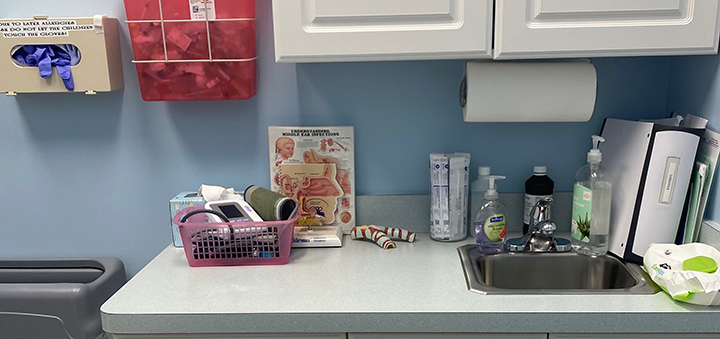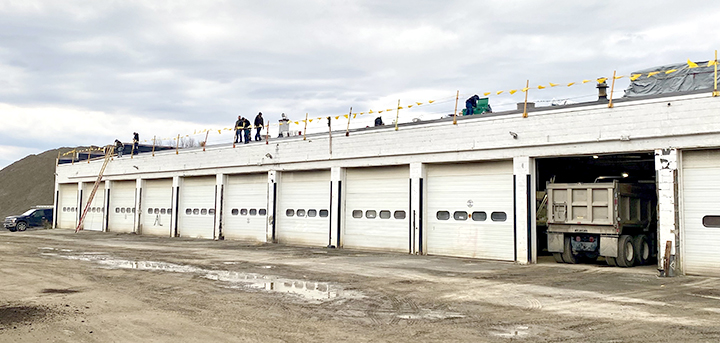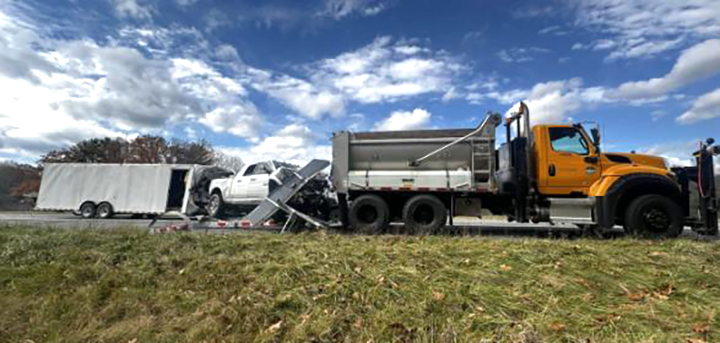Lost years: premature deaths lead Chenango County's unhealthy rankings
Dr. Christine P. Muganda of the University of Wisconsin Population Health Institute said particular areas of weakness within Chenango County’s health rankings are access to primary care and child and infant mortality compared to the rest of the state. (Photo by Lilli Iannella)
CHENANGO COUNTY – Over the past decade, premature deaths helped push Chenango County near the bottom of New York state’s health rankings.
According to <a href="https://www.countyhealthrankings.org/explore-health-rankings/new-york/chenango?year=2023" target=”_blank”><u>compiled data</u></a> by the University of Wisconsin Population Health Institute, Chenango County had the <a href="https://www.countyhealthrankings.org/explore-health-rankings/county-health-rankings-model/health-outcomes/length-of-life/premature-death?state=36&year=2023&tab=1" target=”_blank”><u>third highest</u></a> premature and preventable mortality rate per 100,000 residents under 75 years old across the state in 2023, 12 spots higher than its rating in 2013.
Dr. Christine P. Muganda, the university’s data and analytics team lead, said this premature death rate was “relatively unhealthy” and can tell a lot about the county’s health.
Its 2023 rate was higher than any of its bordering counties– Otsego, Madison, Delaware, Broome and Cortland.
<iframe title="Premature death rate near Chenango County (2013-23)" aria-label="Interactive line chart" id="datawrapper-chart-owRhT" src="https://datawrapper.dwcdn.net/owRhT/3/" scrolling="no" frameborder="0" style="width: 0; min-width: 100% !important; border: none;" height="400" data-external="1"></iframe>
In Chenango County, Muganda pointed out that particular areas of weakness are access to primary care and child and infant mortality compared to the rest of the state.
<b>Child and infant mortality</b>
Besides leading causes of death like cancer and heart disease, Muganda said child and infant mortality in Chenango County contributed to the high rate of premature death.
Both rates were highest among its neighboring counties and stood in the top five highest rates for any county in New York.
A few years ago, when the Chenango County Public Health Department looked into the mortality rate, Director Isaiah Sutton said they found that many instances were associated with poor sleeping techniques, so the county introduced <a href="https://www.co.chenango.ny.us/public-health/nursing/project-safe-sleep.php" target=”_blank”><u>Project Safe Sleep</u></a> in an effort to promote safe newborn sleeping techniques and prevent further mortality.
Although the most recent data is from 2020, post-pandemic, Chenango County Public Health Graduate Fellow Kali Delmar said her department still identified a need to increase prenatal training, and she is currently creating how-to podcasts focused on prenatal and perinatal care.
“That’s what these numbers are pointing out– where we need to allocate our resources,” she said. “It’s education and outreach and trying to reach people where they’re at and the stage of life that they’re in. A lot of these things are extremely avoidable.”
Other significant concerns that can impact infant mortality are drug and tobacco use during pregnancy, Chenango County’s <a href="https://www.co.chenango.ny.us/public-health/nursing/documents/Community%20Health%20Assessment/CHENANGO%20COUNTY%20COMMUNITY%20HEALTH%20ASSESSMENT%202022%20TO%202024.pdf" target=”_blank”><u>2022-24 Community Health Assessment</u></a> said. The county has a region-high incidence of drug use during pregnancy at 11% and a high rate of maternal tobacco use at around 30%, the assessment said.
Drug use can cause <a href="https://www.ncbi.nlm.nih.gov/books/NBK551498/" target=”_blank”><u>neonatal abstinence syndrome</u></a> (NAS), which is when a newborn experiences withdrawal symptoms resulting from maternal opioid use, the National Library of Medicine reported.
Executive Director Kimberly A. Lorraine of the Chenango Health Network, one of the county health department’s partners, said the network recently applied for a grant that supports a community health worker who would work with women of childbearing age in an attempt to reduce the incidence of NAS.
Chenango County also faces an <a href="https://www.evesun.com/news/stories/2023-06-23/38521/%e2%80%9cOn-the-brink-of-death%e2%80%9d%e2%80%94-breaking-down-Chenango-County%e2%80%99s-overdose-crisis" target=”_blank”><u>opioid crisis</u></a>, and according to the <a href="https://webbi1.health.ny.gov/SASStoredProcess/guest?_program=/EBI/PHIG/apps/dashboard/pa_dashboard&p=sh" target=”_blank”><u>New York State Department of Health (NYSDOH) Prevention Agenda Dashboard</u></a>, the county contains the highest rate of patients receiving at least one dose of a <a href="https://www.ncbi.nlm.nih.gov/books/NBK459126/#:~:text=Buprenorphine%20is%20FDA%2Dapproved%20for,opioid%20(such%20as%20heroin)." target=”_blank”><u>buprenorphine</u></a> prescription than any of its bordering counties. The substance is prescribed to treat opioid dependence and sometimes NAS, as indicated by the National Library of Medicine.
Sutton said it is hard to pinpoint the cause of the increasing premature death rate to one factor. But he said the county health department identifies trends in the University of Wisconsin’s national data set in addition to state-reported statistics from the NYSDOH to create three-year Community Health Assessments that help inform program funding decisions.
Although data sets like that of the University of Wisconsin quantify a county’s health status, conversations with those living directly in the communities provide qualitative information to help tell the story behind the data, said Rebecca L. Upton, a Colgate University public and environmental health professor.
“We also have to be skeptical of statistics in some ways. We want to have broader minds and think about the ways that people experience their community and the community’s health, and a data set might not tell you all of that. Good needs assessments will,” Upton said.
Chenango County’s needs assessment also included survey responses from 781 county residents and local providers regarding their top health concerns, which heavily revolved around transportation and access to care.
<b>Transportation</b>
While primary care can be accessed in nearby counties if not available in Chenango, the assessment listed transportation to care and basic needs as the most mentioned social determinant of health.
“‘My life is extremely difficult due to poor transportation for elderly non-drivers, no effective senior center, everything centered around family, and I have none, impossible to get to medical specialists, many of whom are not available at my nearby hospital,’” one respondent in the assessment said.
Chenango County does not have access to commuter train lines, the assessment said, and Chenango First Transit provides bus service through six fixed routes within the county.
<a href="https://www.evesun.com/news/stories/2023-06-28/38542/County-planning-department-seeks-residents%E2%80%99-input-on-public-transportation" target=”_blank”><u>In June</u></a>, the Chenango County Department of Planning launched a county-wide survey for residents to share their thoughts on county transportation options that have not been changed since their 2019 plan.
Out of the first 70 responses, just under a third of people said they don’t live near a public transit route, and over a third said they don’t know where the routes are.
According to the United States Census Bureau, <a href="https://data.census.gov/table?q=car+in+chenango+county&tid=ACSDP5YSPT2021.DP04" target=”_blank”><u>8.5%</u></a> of county households do not own a car, which the assessment said suggests a need for transportation support given the area’s rural nature.
<b>Access to care</b>
While Chenango County is more rural than some of its adjacent counties, like Broome and Madison, survey participants said accessing care can sometimes be challenging.
Upton said people living in rural counties including Chenango and parts of Madison might have to travel farther distances to access specialty care in particular.
“There just aren't the specialty care offices,” she said. “I mean, we just can't support that in some of our rural communities, whether it's Chenango, Madison, wherever. So you end up in Onondaga or somewhere closer to Syracuse.”
Chenango County’s patient to primary care physician is 3,120 to 1, according to the University of Wisconsin data set. Its ratio is more than twice that of Madison County’s and the average of New York state.
Sutton said in Chenango County, there can be a waitlist for local providers, and its rural setting might require traveling to more urban areas to receive specialty services. But he said local residents find ways to access care.
“We may not have that specialist here in Chenango County,” Sutton said. “In 30 minutes, they can be in Binghamton and access that care. So yes, it's not local, and access to care is an issue, but local residents find that care and find a way to access it, maybe more than this study purports.”
In the county, 91% of adults have a regular healthcare provider, the second-highest percentage across Chenango and its neighboring counties, according to the NYSDOH Prevention Agenda Dashboard.
High employment and insurance rates in the county have allowed more people to access care, Sutton said, such as through the Chenango Memorial Hospital, which he described as a resource many small and rural communities don’t have.
During the coronavirus pandemic, telehealth exploded, Upton said. Telehealth provides health information and medical care over a virtual platform, and telemedicine represents the fastest-growing sector of health care, according to the National Library of Medicine.
Many of the University of Wisconsin’s compiled statistics are from 2020 when telehealth use increased, Lorraine and Delmar said, which may have had a positive impact on Chenango County’s patient-to-physician ratio.
Upton also said telehealth represents a way to reach more rural populations without the care being physically located in those areas. She also mentioned how near the Appalachian region, mobile dentistry, in addition to telehealth, has become more prevalent.
<b>What now?</b>
Factors like drug use, access to healthy foods, quality of medical care, employment and educational opportunities are interrelated and affect health, Muganda said, and improving even just one factor can better a county’s overall health.
Lorraine said her network has expanded services throughout the years to respond to both the needs of healthcare entities and an estimate of over 700 community members. She said achieving funding as a non-profit organization can be competitive, and since Chenango County is rural, partnering with other neighboring counties helps them receive grants.
Lorraine said the network partnered with another <a href="https://delawareopportunities.org/about-us" target=”_blank”><u>non-profit in Delaware County</u></a> and has recently been requesting grant money to continue funding its <a href="http://www.chenangohealth.org/substance-use-disorder-community-health-worker/" target=”_blank”><u>community health worker</u></a> position, which supports residents facing substance or alcohol misuse in Chenango, Delaware and Otsego counties.
In neighboring areas, such as Binghamton, The Rural Health Network of South Central New York has partnered with local services and the university to provide the <a href="https://www.health.ny.gov/health_care/medicaid/redesign/sdh/summit_docs/finalist_slides_ruralhealth.pdf" target=”_blank”><u>South Central New York Fruit & Vegetable Prescription Program</u></a>, which serves over 200 people in Broome, Tioga and Delaware counties.
Lorraine said she hopes to see a food prescription program come to Chenango County, where patients receive vouchers for free fruits and vegetables from local stores.
Delmar agreed that a prescription food program could help expand access to healthy foods that would strengthen other health factors.
“It'd be amazing because that's one of the biggest barriers in Chenango County,” she said. “Access to healthy food, getting to a grocery store, and then you combine that with your predisposition to obesity and other things. It's all combined with your community. So I think that answers a lot of our issues.”
Communities will always face certain public health concerns, Upton said, but it comes down to resources and choosing where to allocate funding and what is prioritized.
”We will always have flu, we will always have a strain of COVID, we will always have lots of persistent public health challenges,” Upton said. “The question is about how we prioritize that, and I think that is where funding comes into play too– what are we going to put our money toward?”












Comments